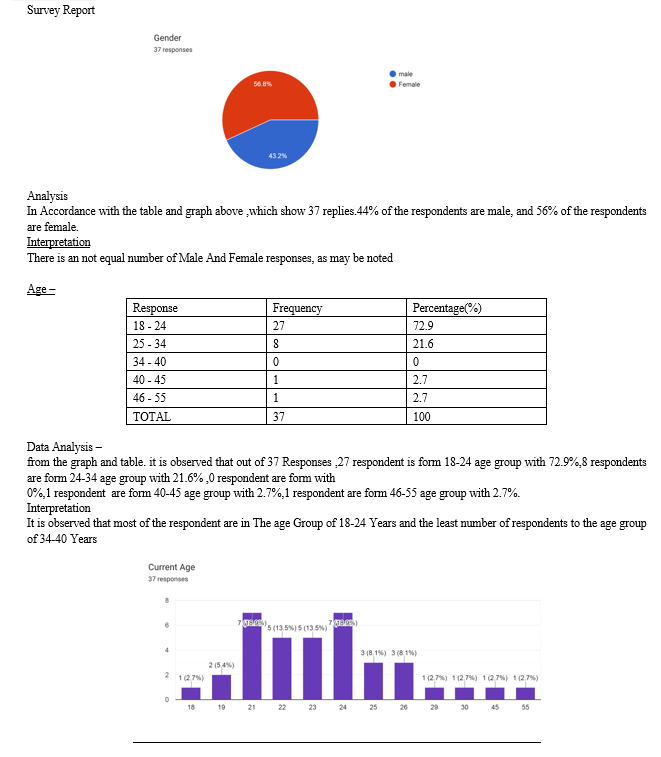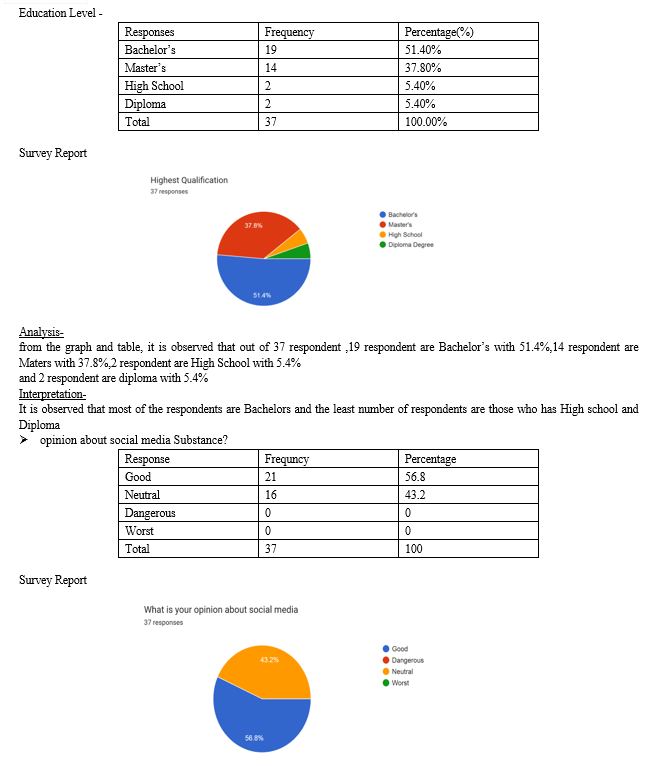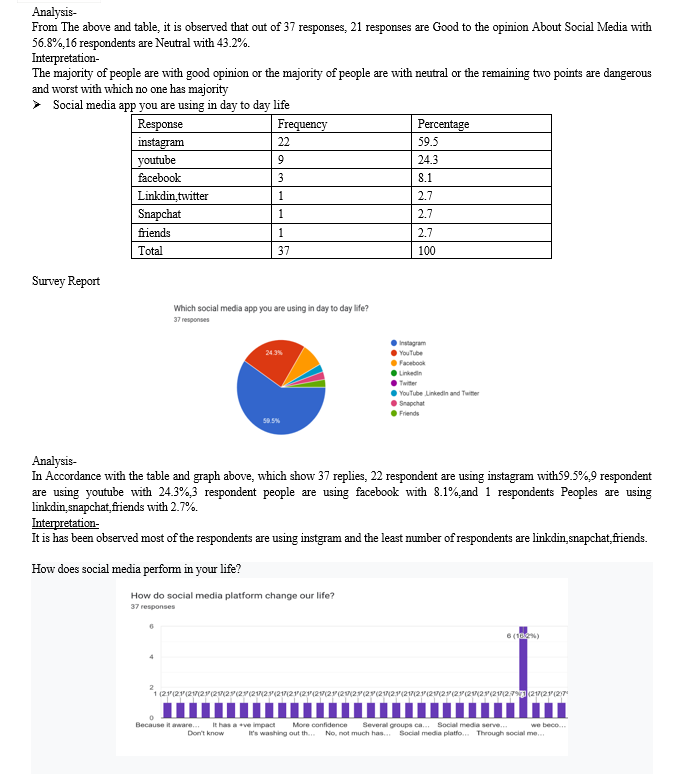Ijraset Journal For Research in Applied Science and Engineering Technology
- Home / Ijraset
- On This Page
- Abstract
- Introduction
- Conclusion
- References
- Copyright
The Impact of Social Media on Consumer Behavior and Purchasing Decisions in the Fashion Industry
Authors: Diwakar Ray Johari, Dr. R. Thanga Prashath
DOI Link: https://doi.org/10.22214/ijraset.2024.62183
Certificate: View Certificate
Abstract
The present study aims to examine the noteworthy impact of social media platforms on customer behavior and purchase decisions in the ever-changing fashion business. Fashion marketers now need to grasp how social media usage affects consumer behavior due to its exponential expansion worldwide, especially among fashion-conscious populations. This study investigates the complex relationship between social media involvement and several aspects of consumer behavior, such as brand awareness, brand loyalty, buy intentions, and actual purchase behavior. It does this by conducting a thorough review of the existing literature and doing empirical analysis. Additionally, the study explores the ways in which brand advertising, influencer endorsements, and user-generated material on social media influence customer perceptions and preferences in the fashion industry. This study integrates theoretical understandings with real-world applications is to offer insightful information to fashion firms and marketers who want to improve their social media tactics and gain a competitive edge in a sector that is becoming more and more digital.
Introduction
I. INTRODUCTION
Sure! Social media has completely changed how people shop for clothes. Before, you might see a fashion ad in a magazine or on TV, but now, with social media, you're bombarded with fashion content every time you scroll through your feed.
Here's how it works: You see influencers and your friends posting about clothes they love, and it makes you want them too. It's like getting fashion advice from your peers 24/7. Plus, with platforms like Instagram and TikTok, brands can directly showcase their latest trends and collections to a massive audience.
So, instead of just relying on what's in stores or what traditional advertising tells you to buy, social media lets you discover new brands, see how clothes look on real people, and get inspired by trends from all over the world. It's like having a personal stylist at your fingertips, and it's changing the way we all think about fashion.
become more seamless than ever before. Consumers can now discover a product on social media, explore its features and reviews, and complete a purchase with just a few taps, all within the same platform.
Furthermore, social media enables the formation of virtual communities centered around shared fashion interests. Online forums, Facebook groups, and Instagram communities provide spaces for enthusiasts to discuss trends, seek style advice, and share shopping recommendations. These communities not only amplify brand messages but also serve as valuable sources of consumer insights, helping brands better understand their audience's preferences and behaviors.
II. INFLUENCING PURCHASING DECISIONS
The influence of social media extends beyond mere brand awareness, significantly impacting consumers' purchasing decisions. Platforms like Instagram and Facebook have integrated shopping features, allowing users to discover and purchase products directly within the app. The rise of shoppable posts, influencer collaborations, and sponsored content has streamlined the path to purchase, blurring the lines between inspiration and transaction.
Additionally, user-generated content plays a pivotal role in shaping consumer perceptions and purchase intentions. Authentic reviews, styling photos, and unboxing videos shared by fellow consumers serve as social proof, validating the desirability and quality of products. As a result, consumers are more likely to trust peer recommendations garnered through social media channels, influencing their willingness to make a purchase
Social media has revolutionized consumer behavior and purchasing decisions within the fashion industry. With the rise of platforms like Instagram, TikTok, and Pinterest, individuals are now exposed to an unprecedented volume of fashion-related content on a daily basis. This constant stream of visual stimuli, coupled with the influence of peers and social media personalities, has profoundly altered the way people discover, evaluate, and ultimately purchase fashion items.
Unlike traditional advertising channels, social media offers a highly personalized and interactive experience. Users can follow their favorite brands, influencers, and friends, creating a curated feed of fashion content tailored to their interests. This direct engagement with brands and fellow consumers fosters a sense of community and trust, making individuals more receptive to marketing messages and product recommendations.
III. REVIEW OF LITERATURE
- Zarei, M., Darvishi, A., and Aghdaie, M. H. (2020). A thorough review of the impact of social media on fashion consumption behaviour. 57, 102198, Journal of Retailing and Consumer Services. 10.1016/j.jretconser.2020.102198This comprehensive analysis looks at the multiple ways that social media has an impact on how people consume fashion, including how it affects their preferences, plans to buy, and brand loyalty on different social media platforms.
- Eckhardt, G. M. and Bardhi, F. (2012). Car sharing is an example of access-based consumption.
39(4), 881–898 in Journal of Consumer Research. 10.1086/665377Through their research on access-based consumption models, such as car sharing, Bardhi and Eckhardt show how consumer behaviour and preferences are influenced by collaborative consumption practices, which in turn cause changes in notions of ownership and sustainability-driven decision-making. - Pham, N. T., Nguyen, T. T., Bui, T. K. T., & Pham, T. H. (2021). The influence of social media personalities on the purchasing intentions of younger consumers with regard to premium fashion brands. 63, 102724, Journal of Retailing and Consumer Services.
10.1016/j.jretconser.2021.102724-02724In this investigation of how young customers' purchase intentions towards luxury fashion labels are influenced by social media influencers, - Banerjee, S.; Chua, A. Y. K. (2016). Social media customer knowledge management: Starbucks's example. Knowledge Management Journal, 20(3), 497–513. JKM11-2015-0476, doi:10.1108Chua and Banerjee examine how Starbucks uses social media interaction to analyse its customer knowledge management tactics, showing how the coffee giant uses user-generated content, reviews, and online forums to improve brand engagement
- Dahl, S., & Eagle, L. (2013). The impact of social media on marketing strategy. Journal of Applied Business Research, 29(3), 687-692. doi:10.19030/jabr.v29i3.7890Dahl and Eagle discuss the transformative impact of social media on marketing strategy, outlining key considerations for integrating social media into traditional marketing approaches, including 6 customer engagement, brand storytelling, content curation, and data analytics for targeted marketing campaigns.
- Albadvi, A., Niaki, M. K., and Dehghani, M. (2014). Using the AHP and COPRAS-G techniques, factors impacting consumers' purchase decisions are evaluated. doi:10.1007/s40092-013-0033-6 Journal of Industrial Engineering International, 10(1), 1–14Dehghani & Co.
Analyse the elements impacting customers' purchase decisions using the analytical hierarchy process (AHP) and COPRAS-G methodologies..
7. Dellaert, B. G. C., van Doorn, J., and Dabholkar, P. A. (2009). The example of the brokerage industry's multiple channel service retailing model. 12(4), 339-356, Journal of Service Research. https://doi.org/1094670509350646Multiple channel service is investigated by Dellaert et al.
Selling tactics in the brokerage sector, emphasising how social media platforms and other digital channels may improve client interaction, service quality.
8. Wu, J., and Fan, Y. (2021). Social media's influence on how consumers interact with fashion brands: The mediating impacts of perceived social media marketing initiatives for brands. 58, 102304, Journal of Retailing and Consumer Services. 10.1016/j.jretconser.2020.102304In order to show how perceived brand social media marketing activities mediate consumer engagement, loyalty, and purchase intentions, Fan and Wu investigate how social media shapes customer engagement behaviours in fashion brand communities.
IV. OBJECTIVE OF RESEARCH
- To investigate how social media sites like Facebook, Instagram, and TikTok affect how customers behave in the fashion sector.
- To examine how social media use and purchase decisions are related, including
Brand loyalty, impulsive purchasing, and product preferences. - Investigating how social media influencers, celebrities, and user-generated material affect how customers view fashion businesses and items.
- To look into how various social media marketing techniques (including sponsored posts, influencer partnerships, and user-generated content campaigns) affect customer engagement and intent to buy.
V. HYPOTHESIS
- H0 - The majority of influencing factors do not significantly affect consumers' decisions to buy clothes via social media sites.
H1 - The majority of influencing factors have a substantial impact on consumers' decisions to buyclothing via social media channels.
2. H0 - Customers' experiences making purchases on social media platforms have no discernible influence on whether or not they recommend social media purchases to others.
H1: Consumers' experiences making purchases on social media platforms have a big influence on whether or not they promote social media purchases to others.
VI. SCOPE OF THE STUDY
The purpose of the study is to determine how important social media is to customers' online purchases made on digital platforms.With the development of sophisticated technology, social media has attracted significant interest from the younger generation, who make up a large portion of themarket within the fashion sector.The potential future scope of this research can be determined by taking into account the market standards of the apparel business, where social media plays a significant role.Regarding the potentimpact of social media on consumer decision-making, the fashion industry enjoys widespread recognition on digital platforms.
- Data Collection: Gather information from social media sites, such as user comments, engagement metrics, photos, videos, and posts. Make that the information gathered is thorough, reflective of the intended audience, and reflects the patterns being studied.
- Methods of Analysis: Utilise suitable analysis methods to make sense of the information gathered.This could involve sentiment analysis of user comments, quantitative study ofengagement data, and qualitative analysis of content trends and topics..
VII. RESEARCH METHOLODGY
A. Research Design
Research design comprises the research philosophy, research approach, research strategy, time horizon, techniques, and processes. It also defines the overall framework of the research methodology. The study's research philosophy falls within the positivistic category
B. Population And Sample
The population is the totality of the individuals under investigation by the researcher. Stated differently, the population comprises every aspect of the research. The mid-year population estimates state
C. Data Collection
The questionnaires served as the main source of data for this study.
As a result, target respondents were given surveys both offline and online, and secondary data were acquired by consulting earlier research and other secondary sources.
VIII. DATA ANALYSIS AND INTERPRETATION
Gender
|
Response |
Frequency |
Percentage |
|
Male |
16 |
44 |
|
Female |
21 |
56 |
|
Total |
37 |
100 |



Analysis and interpretation
It has been observed that , majority of the population thinks that change life style,not much changed,we become more aware and get many information and thanThe answer of many people is yes because social media brings changes in lifestyle
IX. FINDINGS
- The majority of respondents are age 18-24 years, with the least number of respondents to the age group of 34-40 Years
- It is observed that most of the respondents are Bachelors and the least number of respondents are those who has High school and Diploma
- The majority of people are with good opinion or the majority of people are with neutral or the remaining two points are dangerous and worst with which no one has majority
- It has been observed that , majority of the population thinks that change life style,not much changed ,we become more aware and get many information and thanThe answer of many people is yes because social media brings changes in lifestyle
Conclusion
The study of Social media\'s effects on consumer behavior and fashion industry purchase decisions.it is observed that out of 37 Responses ,27 respondent is form 18-24 age group with 72.9%,8 respondents are form 24-34 age group with 21.6% ,0 respondent are form with0%,1 respondent are form 40-45 age group with 2.7%,1 respondent are form 46-55 age group with 2.7%.Moreover, of the 37 respondents, 19 have a bachelor\'s degree (51.4%), 14 have a master\'s degree (37-8%), 2 have a high school degree (5.4%), and 2 have a diploma (5.4%). And than the research was limited to 37 people and focuses on social media platformsn this change, user-generated material is also quite important. Peer evaluations and shared experiences are more trusted by consumers than traditional advertising, which helps firms appear more real and builds a following of devoted patrons. Good visual material is crucial since posts with eye-catching imagery better engage and draw in potential customers.
References
[1] Yongjian, C., Fischer, E., and Smith, A. N. (2012). What are the differences between user-generated material related to brands on Facebook, Twitter, and YouTube? 26(2), 102-113, Journal of Interactive Marketing. [2] Haenlein, M., and A. M. Kaplan (2010). Users everywhere, band together! Social media\'s opportunities and challenges. Horizons in business, 53(1), 59-68. [3] Smit, E. G., Moorman, M., and D. G. Muntinga (2011). Presenting COBRAs: Investigating Reasons for Using Social Media for Brands. Journal of Advertising International, 30(1), 13–4 [4] Ko, E., and A. J. Kim (2012). Do marketing initiatives on social media increase client equity? an actual investigation of a high-end fashion label. 65(10) of the Journal of Business Research, 1480–1486 [5] Benyoucef, M., and Zhang, Y. (2016). an investigation at how social media affects 58(3), 387–404, International Journal of Market Research. [6] Solomon, M. R., and Tuten, T. L. (2018). marketing on social media. Sage Books. [7] S. Okazaki (2009). Consumer product ratings are examined in relation to the social influence model and electronic word-of-mouth. 13(3), 73-91, International Journal of ElectronicCommerce. [8] Jin, S. V., Phua, J., and Kim, J. J. (2017). Benefits of following brands on Facebook, Twitter, Instagram, or Snapchat: The moderating influence of network homophily, social comparison, trust, and tie strength on brand recognition, engagement, and commitment as well as membership intention. 34(1), 412-424; Telematics and Informatics. [9] Dholakia, R. R., and K. P. Chiang (2003). An empirical examination of the factors that influence consumers\' intention to shop online. 13(1-2), 177–183, Journal of Consumer Psychology.
Copyright
Copyright © 2024 Diwakar Ray Johari, Dr. R. Thanga Prashath. This is an open access article distributed under the Creative Commons Attribution License, which permits unrestricted use, distribution, and reproduction in any medium, provided the original work is properly cited.

Download Paper
Paper Id : IJRASET62183
Publish Date : 2024-05-15
ISSN : 2321-9653
Publisher Name : IJRASET
DOI Link : Click Here
 Submit Paper Online
Submit Paper Online

